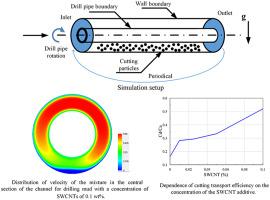单壁碳纳米管改性钻井液对岩屑运移的系统数值研究
IF 4.3
2区 材料科学
Q2 ENGINEERING, CHEMICAL
引用次数: 0
摘要
对单壁碳纳米管(SWCNT)改性钻井液在悬浮液层流条件下的输运进行了系统的数值研究。通过与实际井和钻井模式相对应的广泛参数变化,考察了钻井液质量流量、浆体粒径、内外管径比、偏心、内管转速和井斜角对改性钻井液浆体颗粒输运效率的影响。通过模拟井,研究了添加剂对环空通道中浆体颗粒浓度分布和混合物速度的影响。确定了纳米管影响浆料颗粒输运的机理。结果表明,在所有考虑的情况下,纳米管改性钻井液的颗粒输运效率随着添加剂浓度的增加而显著提高。swcnts浓度为0.1 wt%的钻井液对提高井筒清洁效果最为有效。与基准流体相比,该流体输送浆体的能力增加了3.4倍,而压降仅增加了1.8倍。此外,研究还发现,纳米管的添加对于同心管布置、低钻杆转速和高钻井液质量流速的水平井最为有效。本文章由计算机程序翻译,如有差异,请以英文原文为准。

Systematic numerical study of cuttings transport using drilling fluids modified with single-walled carbon nanotubes
A systematic numerical investigation of slurry transport by drilling fluids modified with single-walled carbon nanotube (SWCNT) additives under laminar flow conditions of the suspension has been conducted. Across wide-ranging parameter variations corresponding to real wells and drilling modes, the effects of the mass flow rate of the drilling fluid, particle size of the slurry, ratio of inner to outer pipe diameters, eccentricity, rotational speed of the inner pipe, and well inclination angle on the efficiency of slurry particle transport by the modified fluids were examined. The influence of the additives on the concentration distribution of slurry particles and the velocity of the mixture in the annular channel, simulating the well, was studied. Mechanisms of the nanotubes' influence on slurry particle transport were identified. It was demonstrated that for all considered cases, the efficiency of particle transport by drilling fluids modified with nanotubes significantly increases with increasing additive concentration. The greatest effectiveness for improving wellbore cleaning was exhibited by a drilling fluid with an SWCNT concentration of 0.1 wt%. For this fluid, the ability to transport slurry increased by a factor of 3.4, while the pressure drop increased only by a factor of 1.8 compared to the baseline fluid. Furthermore, the addition of nanotubes was found to be most effective for horizontal wells with concentric pipe placement, at low rotational speeds of the drill pipe, and at high mass flow rates of the drilling fluid.
求助全文
通过发布文献求助,成功后即可免费获取论文全文。
去求助
来源期刊

Particuology
工程技术-材料科学:综合
CiteScore
6.70
自引率
2.90%
发文量
1730
审稿时长
32 days
期刊介绍:
The word ‘particuology’ was coined to parallel the discipline for the science and technology of particles.
Particuology is an interdisciplinary journal that publishes frontier research articles and critical reviews on the discovery, formulation and engineering of particulate materials, processes and systems. It especially welcomes contributions utilising advanced theoretical, modelling and measurement methods to enable the discovery and creation of new particulate materials, and the manufacturing of functional particulate-based products, such as sensors.
Papers are handled by Thematic Editors who oversee contributions from specific subject fields. These fields are classified into: Particle Synthesis and Modification; Particle Characterization and Measurement; Granular Systems and Bulk Solids Technology; Fluidization and Particle-Fluid Systems; Aerosols; and Applications of Particle Technology.
Key topics concerning the creation and processing of particulates include:
-Modelling and simulation of particle formation, collective behaviour of particles and systems for particle production over a broad spectrum of length scales
-Mining of experimental data for particle synthesis and surface properties to facilitate the creation of new materials and processes
-Particle design and preparation including controlled response and sensing functionalities in formation, delivery systems and biological systems, etc.
-Experimental and computational methods for visualization and analysis of particulate system.
These topics are broadly relevant to the production of materials, pharmaceuticals and food, and to the conversion of energy resources to fuels and protection of the environment.
 求助内容:
求助内容: 应助结果提醒方式:
应助结果提醒方式:


